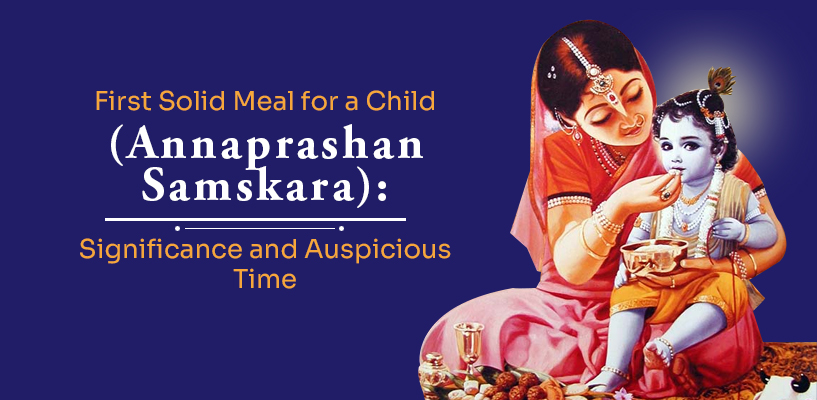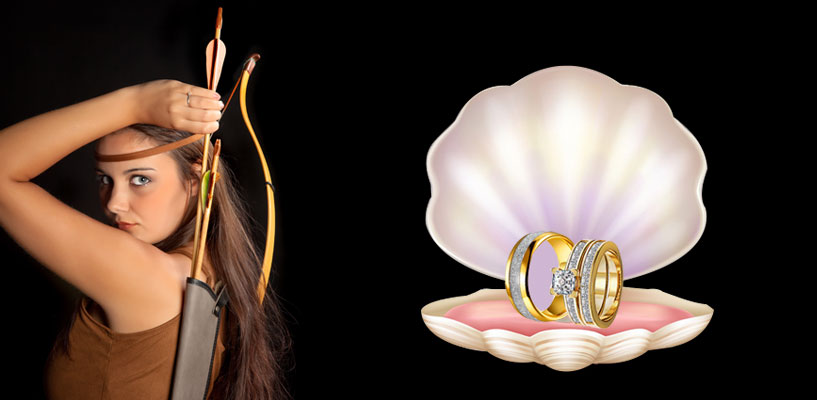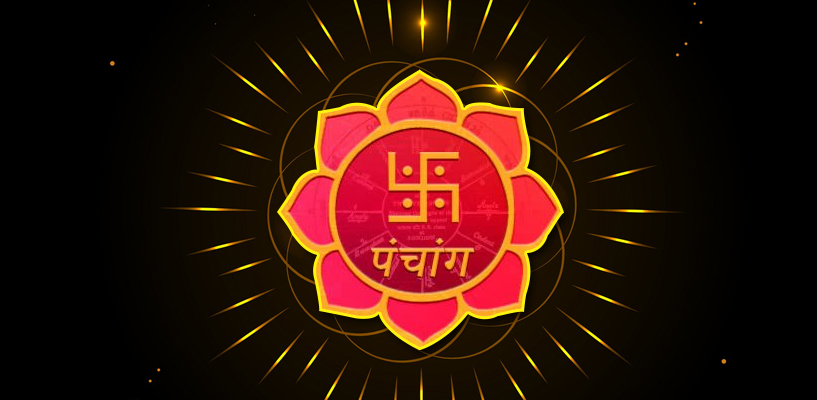First Solid Meal for a Child (Annaprashan Samskara)
What is the significance of the first solid meal in a child’s life? How is this ritual performed under the Vedic tradition? What is the auspicious time? Read this article for answers.
The significance of samskara (rite of passage) has been addressed at length in many religions by their reliable and ancient books. In the Hindu Maha Nirvana Tantra, which is a treatise on the questions that accompany a person’s circle of life, this has been articulated through a conversation between Lord Shiva and his consort, Parvati. It has also been described in detail in the ancient texts such as the Vedas and Puranas.
This forecast is based on Moon Sign. If you are not aware of your Moon Sign, find out instantly for free by filling the data below:
There are 16 samskaras in the Hindu tradition, which can be classified as:
- Three pre-natal samskaras
- Twelve post-natal samskara
- One post-mortem samskara
In the Hindu life cycle, every single junction or turning point appears to have a spiritual overtone and hidden agendas. Out of many such stages which directly shape the future course of an individual’s life, the sixteen milestones or samskaras have been identified as most important, which require special care and treatment.
If we look at cultures across the world, we see that all have samskaras (rites of passage) based on their belief systems and sacred texts.
- In China, people draw their samskaras from Buddhism, Taosim, Islam, Catholicism, and Protestantism.
- Zoroastrians draw their samskaras from their belief that there is one universal, transcendent and supreme creator, Ahura Mazda or the ‘Wise Lord’.
- The Jews base their samskaras on an Abrahamic monotheistic religion based on the life and teachings of Jesus of Nazareth.
- Those who follow Islam, draw their samskaras from the teachings of Muhammad, the Messenger of God.
- Likewise, African traditional religions, Judaism, Bahai, Jainism and many other traditional belief systems have amazingly explained metamorphoses that have occurred in individuals or systems after a samskara or a sacrament was performed sincerely.
Annaprashan: Its Significance
Of the 16 samskaras in the Hindu tradition, Annaprashan marks an individual’s early stages of their life cycle. It is the baby’s first introduction to solid food in the 6th or 8th month. Similar rituals can be seen across the world. For instance, the English refer to it as ‘first feeding with rice’ and the ceremony is carried out when the child is 6-8 months old. This is the time when teeth begin to appear in the baby.
All around the world, the first solid food that is given to a baby reflects the given culture’s native cuisine. Basically, they are given a gentle version of the food that the family consumes. This is crucial as it establishes healthy eating habits and preferences for ingredients that are locally available.
Tips for safe Annaprashan
Paediatricians advice that a baby should be on mother’s milk till six months, after which they should be gradually introduced to semi-solid food for proper growth and nourishment. This gradual shift helps the baby to improve eating skills and to learn different textures, tastes and smell. During teething, the baby can be introduced to veggies and fruits which can help them to hold and chew properly. The food can be mashed or puréed to help them digest.
However, early introduction of the weaning process may develop gastrointestinal and allergy problems for the baby. Hence, the food should not be salty, chilly, oily, or hot. It should be prepared keeping hygiene in mind; and should be served to the baby when food is served to the other family members as well. This has several benefits related to the baby’s emotional and social development.
A few things to keep in mind for a safe ceremony:
- Ensure your baby is well rested and doesn’t get cranky.
- Choose comfortable clothes for your baby.
- Best to limit the gathering as your baby may feel overwhelmed.
- Wash your hands thoroughly before feeding the baby.
- Ensure your baby’s food is fresh and hygienic.
- During havan keep your baby’s face away from the smoke.
- Remember, feeding the Annaprashan food is more symbolic as it may upset their tummy.
Annaprashan: A Vedic Tradition
Annaprashan is a Sanskrit term which literary means grain initiation. It’s a ceremony of the first grain feeding of the baby and is known as Choroonu in Kerala, Mukhe bhaat in Bengal and Bhaatkhulai in the Garhwal areas. The rites of the ceremony may differ according to different religions.
It is celebrated when your baby is ready for the transition from liquid to solid diet.
Procedure followed:
- Give a holy bath to the baby by adding drops of Ganga Jal (water from the Ganges, which is considered holy) to the bathing water.
- The baby should be in a new dress. It should be comfortable. You can also make the baby wear a garland and other decorative ornaments.
- The ceremony is usually celebrated in a temple dedicated to Lord Krishna, to symbolise Lord Krishna’s blessing upon the child.
- Make the baby sit on the lap of the father / grandfather / maternal uncle (Mama) / Aunt as per your choice and the comfort of the baby.
- The kheer / ghee rice should be first offered to Lord Krishna after the puja has been performed. After that, offer it to the baby on a gold or silver ring or a silver spoon so that the baby can lick the food. The food should be first offered to the baby by the priest, parents and then by the grandparents – praying for the child’s good health and longevity. Avoid making everybody feed the baby as this might cause discomfort to the child and can also result in indigestion.
These days we also see that the Annaprashan ritual is combined with Bhumi Upveshanam, which is related to the first seating of the baby on earth and articles like clothes, books, food items, pen, toys, clay, etc. are placed before the child. The belief is that whichever article the child touches or grabs will indicate the future source of livelihood for the child. This ceremony is often followed by a fun game, a great time cheering the child and family members. The various articles are attributed different meanings - books symbolize learning, jewels mean wealth, the pen indicates wisdom, clay means property, and food items indicate a love for food.
A similar tradition as the Bhumi Upveshanam is to be seen in the Chinese culture, dating back to the Song Dynasty (960-1279). During the child’s first birthday, Zhuazhou is performed where relatives gift the child dimsums or toys. The family installs a table on the bed where stamps are placed along with classic Confucian, Buddhist and Taoist books; a Chinese brush pen; ink, paper and an ink stone; abacus; coins; an accounting book; jewellery; flowers; food; and toys. For girls, they also add things like a spoon to represent cooking utensils and other items to stand for sewing items. The child is then seated in front of the table and is allowed to pick up an item without anyone’s assistance. The selected items are supposed to foretell the child's interests and future.
Choosing a Muhurat for Annaprashan
Muhurat or Muhurta is a moment created by various positions of the planets and its five limbs are Tithi, Vaar, Nakshatra, Karan, and Yoga which contain certain vibrations that affect an individual’s life. The muhurat also affects the action being performed that day and the process of life starting at that time. It also plays a huge role in the fructification of the event.
Auspicious time for Annaprashan
For a male child, the ceremony should be performed in the 6th, 8th or 10th month. For a female child, the ceremony should be performed in the 5th, 7th and 9th month. The favourable Nakshatras, Tithis, Vaar, Ascendant and planetary configurations should be properly analysed before fixing a date and time.
If you want to order the muhurat for your child’s Annaprashan ceremony click here.
Indastro top 10 Products
Translate











 Tenth House: The House of Career
Tenth House: The House of Career
 Best Compatibility Match for Sagittarius Woman
Best Compatibility Match for Sagittarius Woman
 Astrological Remedies for Overcoming Delay in Marriages
Astrological Remedies for Overcoming Delay in Marriages
 Does the Universe really help us with Future Forecasts?
Does the Universe really help us with Future Forecasts?
 Personal Panchang and Its Influence on the Natal Chart
Personal Panchang and Its Influence on the Natal Chart
